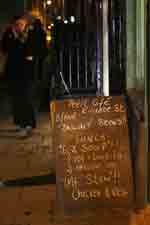Bord Bia report advises wet houses to consider casual food
It points out that foodservice sales are dominated by the commercial sector, accounting for some 88 per cent of market value in 2010.
“Consumer traffic has been down, but not by as much as would have been expected,” states the report which acknowledges that pubs have had “an extremely challenging time with sales falling by 9.2 per cent cent per annum CAGR) between 2008 and 2010.
Pubs account for the lion’s share of the ‘Pubs, Cafés, Coffee Shops’ channel revenue – some 86 per cent in 2010 – and its performance shaped the channel decline of 8.2 per cent (CAGR) from 2008 to 2010.
Drivers and trends in the channel 2008-10
On-the-go and casual dining have been international success stories over the past few years and are anticipated to grow at several times the growth rate of the total Irish foodservice market over the next four years.
During the economic downturn consumers traded down to lower cost eating out options such as on-the-go and casual dining.
People now seek less formal, less structured and more convenient foodservice occasions, stated the report, adding, “They’ve overlapped with and take sales from the more traditional channels – notably white table cloth and quick service restaurants”.
Bord Bia’s reason for examining these two markets in depth is threefold:
* They have both been remarkably resilient to the worst effects of the economic downturn
* They reflect powerful and ongoing consumer trends
* Their growth path is set to continue and they will move centre-stream in
foodservice over the next few years.
According to Bord Bia, pubs’ dependence on alcohol sales was under pressure even before the recession, but the need for additional revenue streams has been brought into sharp focus by it.
“The lower unit cost of sales in pubs mean that they are highly traffic-driven which means that good location has become all the more important to survival:
* As pub overheads are high (property and staff costs) the volume of footfall is critical to survival
* Urban pubs, particularly those in Dublin, with their higher traffic potential have performed better than rural areas
* Rural locations for both pubs and cafés have been particularly hard hit
* Discounting has resulted in much tighter margins which rely on higher volumes of footfall to compensate.”
Bord Bia also points out that normally in time of economic downturn alcohol sales hold-up well, acting as a sort of social pressure valve.
“The difference this time is an indication of alcohol’s changing position in society.”
Given their recession performance and the changing relationship society has with alcohol, pubs need to review their business model and question whether they can prosper long-term with such a dependence on one income stream, advises the report.
“The answer when faced with similar problems in the UK was a clear ‘no’,” it stated, “While not suggesting that the UK scenario will transfer completely to Ireland, it does highlight a number of interesting indicators. The UK experience is that few alcohol-only pubs can survive.
– Over the past decade the number of pubs in the UK has declined dramatically; most of those that closed were alcohol-dependent for the majority of their income
– Today in the UK most pubs that rely on alcohol sales will still obtain at least 20 per cent of sales from food (an estimated 30 per cent of the pub stock)
– Large numbers of pubs have followed the casual dining route and now obtain circa 50 per cent of their income from food (an estimated 60 per cent of the pub stock)
– A significant proportion have gone the “whole hog” and are now classified as restaurants obtaining circa 80 per cent from food (an estimated 10 per cent of the pub stock).”
Bord Bia predicted that in Ireland, if the current situation persists, pubs are likely to have declined by a further 5.7 per cent in 2011 and then will grow by just under one per cent (CAGR) per year from 2010 to 2015.
According to the report, “In 2011 the indications are that quick service restaurants will replace pubs, cafés and coffee shops as the largest Irish foodservice channel”.
 On-the-go and casual dining have been international success stories over the past few years and are anticipated to grow at several times the growth rate of the total Irish foodservice market over the next four years.
On-the-go and casual dining have been international success stories over the past few years and are anticipated to grow at several times the growth rate of the total Irish foodservice market over the next four years.








